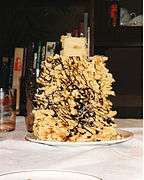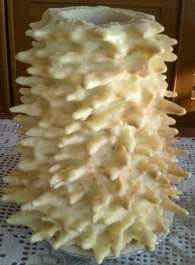Šakotis
|
Lithuanian šakotis | |
| Type | Cake |
|---|---|
| Region or state | Lithuania, Poland |
| Creator | Bona Sforza or the Yotvingians |
|
Sękacz]] Sękacz]] | |
Lithuanian šakotis, Polish sękacz ("tree cake"; literally "branchy"[1]) is a Polish-Lithuanian traditional spit cake. It is a cake made of butter, eggs, flour, sugar, and cream, cooked on a rotating spit in an oven or over an open fire.
History
The cake became popular during the Polish-Lithuanian Commonwealth (1569–1791). Its origins are attributed to either the Italian Queen Bona Sforza of Poland or the Baltic tribe of Yotvingians. The Yotvingians settled in the early and high Middle Ages in Podlasie, while Bona Sforza is known to have implemented many agriculture, infrastructure and manufacture reforms.[2]
Its name means "branched tree" or "tree with many branches" due to its distinctive shape (it is often conical, like a pine tree, and with the drips as branches). It is baked in a time- and labor-intensive process,[3] by painting layers of dough onto a rotating spit in a special open oven or over an open fire.
It can be decorated with chocolate and flower ornaments, but it is often served plain. Šakotis is one of the most important desserts in Lithuanian celebrations, especially at weddings or other special occasions such as Christmas.[4]
It was the sweet chosen to represent Lithuania in the Café Europe initiative of the Austrian presidency of the European Union, on Europe Day 2006.
In May 2015, in Druskininkai, Lithuania the record of the biggest šakotis was broken with 372 centimetres (12.20 ft) height and 85.8 kilograms (189 lb) weight.[5]
Gallery
- Making process
- Plain, low examples of soft Šakotis
 Šakotis decorated with chocolate and coconut shavings
Šakotis decorated with chocolate and coconut shavings- Tall Šakotis example, decorated with chocolate and flowers
 The cake (center) served onto plates (right and left) showing characteristic cake layers resembling growth rings
The cake (center) served onto plates (right and left) showing characteristic cake layers resembling growth rings
See also
External links
References
- ↑ Lankauskas, Gediminas (2015). The Land of Weddings and Rain: Nation and Modernity in Post-Socialist Lithuania. U of Toronto P. pp. 208–11. ISBN 9781442612563.
- ↑ Klaus Klöppel: Polnische Ostseeküste: Danzig, Masuren, Baedeker, ISBN 3-8297-1171-9 Archived January 7, 2014, at the Wayback Machine.
- ↑ Bremzen, Anya von (2014). Det goda sovjetiska köket: Minnen, mat och längtan (in Swedish). 2244. p. 242. ISBN 9789186729592.
- ↑ Baker, Mark; Presser, Brandon; Dragicevich, Peter; Richmond, Simon; Symington, Andy (2012). Lonely Planet Estonia, Latvia & Lithuania. Lonely Planet. p. 43. ISBN 9781743213049.
- ↑ Lietuvoje pasiektas rekordas: iškeptas didžiausias pasaulyje šakotis


